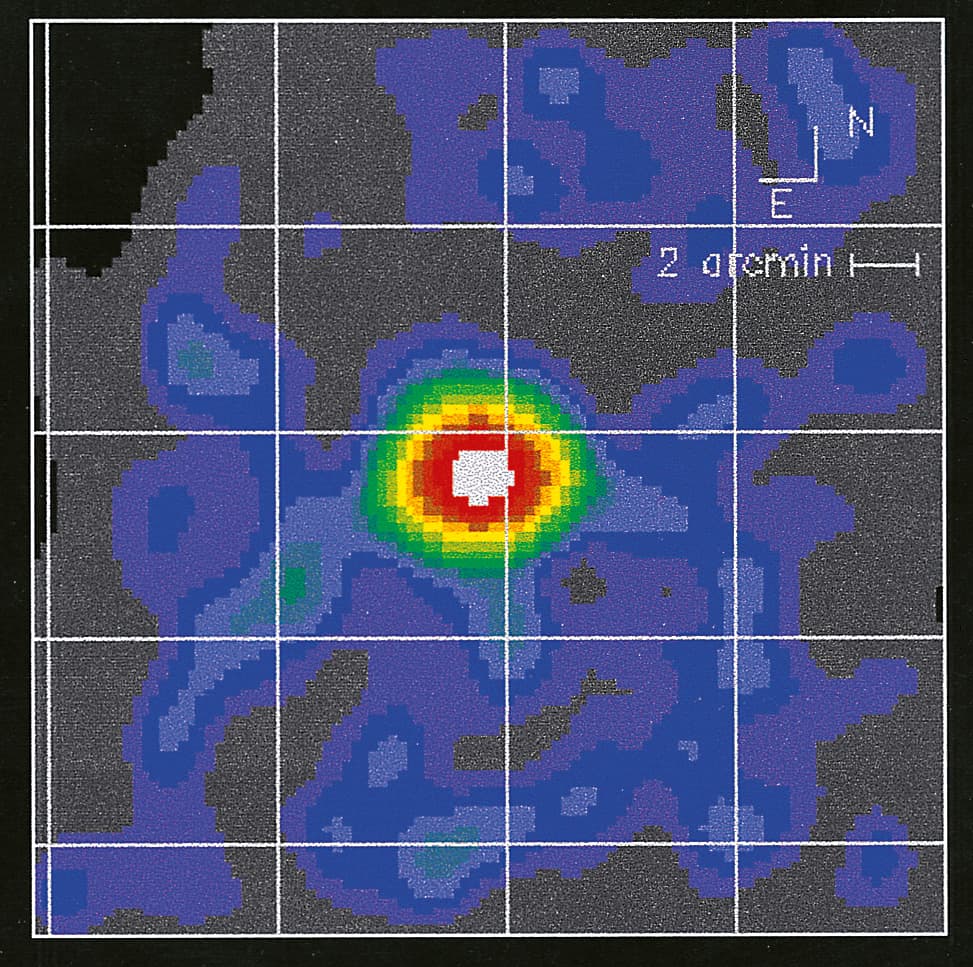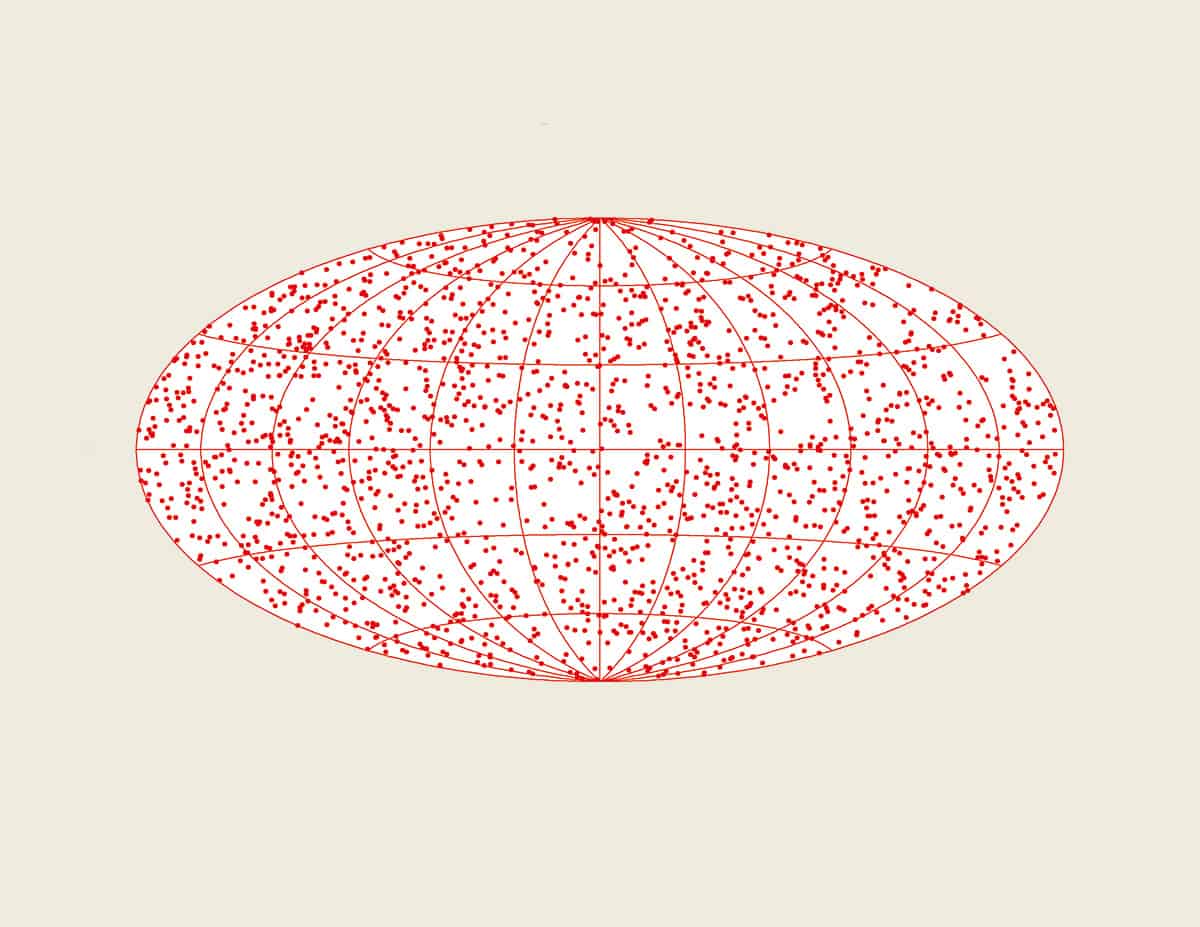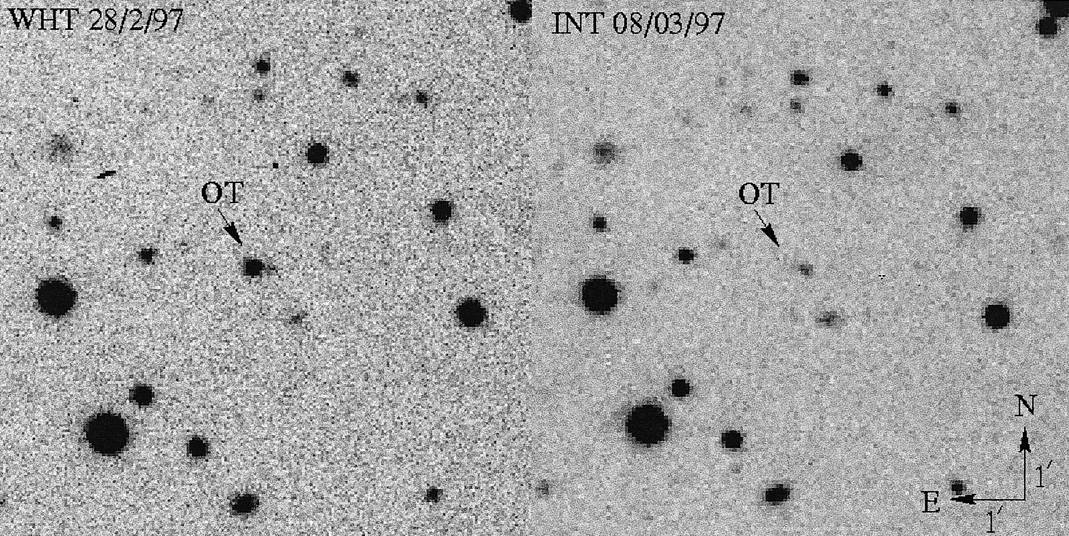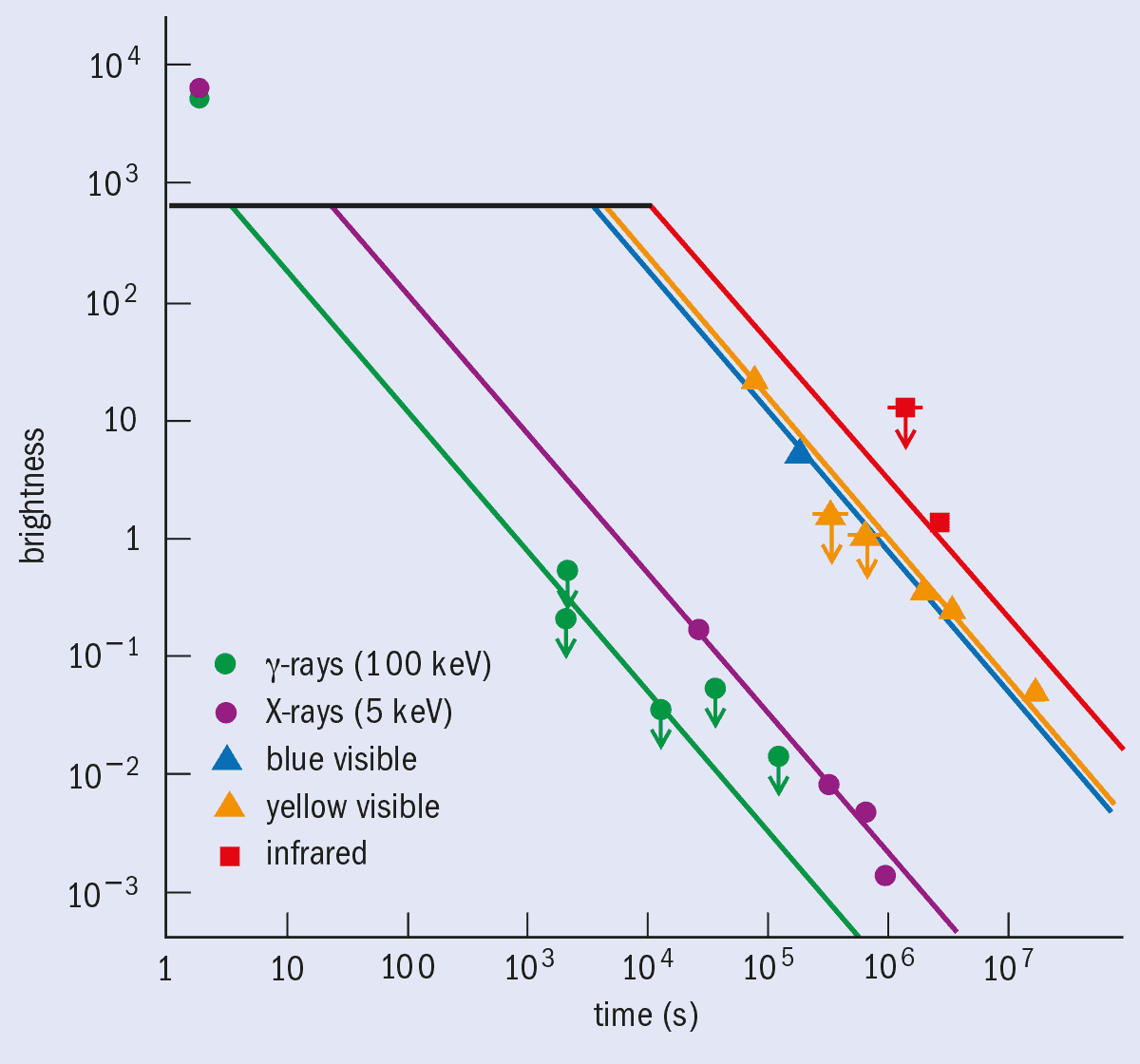The discovery of visible light from gamma-ray bursts has revealed that these puzzling objects lie among the most distant quasars and galaxies in the universe, while radio observations have highlighted their ultrarelativistic nature

Gamma-ray bursts are one of the top unsolved mysteries in astrophysics, alongside such burning issues as the nature of dark matter and the cosmological constant. We have known of the existence of gamma-ray bursts for over 25 years, but these short flashes of gamma rays have defied all our attempts to understand their causes and origin.
New clues to the mystery were provided on 28 February 1997, when the BeppoSAX satellite located a gamma-ray burst more quickly and precisely than ever before. This allowed astronomers to image the burst, revealing a rapidly fading point of light near a faint nebula. Another gamma-ray burst was found in the same way a few months later, and this time the optical spectrum was recorded by the Keck telescope on Hawaii. This told us unambiguously that gamma-ray bursts lie at the very edges of the universe, making them the most energetic phenomenon we know of.
Although these findings have solved part of the puzzle, we still do not know what causes gamma-ray bursts. Their formation appears to be related to the deaths of massive stars, and almost certainly requires matter to be flung into space at close to the speed of light. The bursts are so bright that they can be detected out to very great distances, and could even hold the record for the most distant known objects. In principle, more sensitive detectors could see gamma-ray bursts from even further away. This could prove to be the only way of observing the early universe, when the first stars and galaxies were forming.
The gamma-ray sky: a burst a day
If you looked at the heavens in gamma rays, you would recognize very little of the normal night sky. Gamma rays typically have energies of 1 MeV, while visible light is recorded at energies of around 1 eV. The Sun would still be visible, but none of the usual constellations or stars would be seen. Instead the sky would be dominated by the Milky Way, which usually appears as a faint band of stars that can only be seen away from city lights.
Gamma rays do not come from these stars, but from big gas clouds that drift between the stars. Cosmic rays excite the nuclei inside the clouds and trigger nuclear reactions, leading to the emission of gamma rays. We would also see a few star-like sources of gamma rays, mainly black holes in the Milky Way and beyond – the material just outside black holes is hot enough to emit gamma rays.
But the most striking observation would be intense flashes of gamma rays that occur several times every day. These gamma-ray bursts (GRB) typically last for a few seconds but are incredibly diverse: some last a few milliseconds, while others extend beyond 15 minutes; some decay smoothly with time, while others show many sharp spikes in their light curves.
Gamma rays are absorbed by the atmosphere, so cannot be detected from the ground. The first GRB was detected on 2 July 1967 by Vela 4a, a satellite flown to verify that nuclear weapons were not being exploded in space. However, the discovery was not made public until 1973 because the satellite did not provide any directional information, making it difficult to establish the bursts as extraterrestrial objects. The workhorse for studies of gamma-ray bursts today is the Burst and Transient Source Experiment ( BATSE) on board NASA’s Compton Gamma Ray Observatory. BATSE was launched in 1991 and detects about one burst every day – it notched up its 2000th burst at the end of last year.

Before BATSE, almost everyone thought that GRBs came from nearby areas of our galaxy. Fainter ones would then lie in the Milky Way band, still within our galaxy but further away. But this theory was shattered when the BATSE team announced results from their first year of observing weak bursts: the recorded locations revealed no pattern at all, indicating that any part of the sky can produce a gamma-ray burst.
This finding convinced many astronomers that gamma-ray bursts had to come from the distant edges of the universe, because only the universe looks the same in all directions. But some researchers maintained that the bursts came from the edges of our galaxy. This is about a thousand times further away than the region the bursts were thought to have come from, but is still 100 000 times closer than the distant reaches of the universe.
A needle in a haystack
A great deal of effort was devoted to finding out the distances to gamma-ray bursts, and some successes were reported. In 1994 Jay Norris and colleagues at NASA’s Goddard Space Flight Center in Greenbelt, Maryland, discovered that faint bursts last longer than bright ones. They attributed this to a “redshift stretching” of the fainter bursts, which implies that the faint bursts are at high redshift and are therefore further away. However, the result failed to convince many people who believed in a galactic origin.
What was really needed was an observational breakthrough. One approach was to observe gamma-ray bursts at different wavelengths – many riddles in astronomy have been solved by looking at a new, enigmatic type of object at other wavelengths. This provides more information about the object and often pinpoints exactly what it is. This was certainly the case for radio stars in the 1950s, thought by some to be nearby stars and by others to be distant galaxies. Martin Ryle, the main proponent of the nearby-stars interpretation, accepted defeat when Walter Baade and Rudolph Minkowski recorded an optical image of the radio source Cygnus A, clearly showing it to be a distant galaxy. There was a similar controversy over quasars, which looked like stars in optical images. But when Cyril Hazard obtained an accurate location for the quasar 3C 273 from lunar occultation, Maarten Schmidt was able to record the famous spectrum that finally settled the issue. (The acrimony over how the credit for this discovery was divided between the people who located the object accurately and those who analysed it was as great for quasars then as it is for GRB now. With quasars, Hazard never got the credit he was due; this mistake should not be repeated.)
However, apart from a few X-rays, no radiation at other wavelengths had ever been recorded from a gamma-ray burst. This is largely due to the fact that gamma rays penetrate materials very easily, which means that they cannot be detected using conventional imaging optics such as lenses and mirrors. Indeed, the detectors on BATSE are essentially flat plates of sodium iodide that absorb and count every incident gamma-ray photon. Eight detectors are mounted on the satellite, each seeing half the sky and facing in a different direction.
A single gamma-ray burst is typically seen by four of the detectors, and the flux each one measures is large if the detector faces the source of the burst, and smaller if it lies at an angle. A best position for the gamma-ray burst can be found by analysing the fluxes measured by all of the detectors, but this is typically a circle about 20 times the size of the full moon. Within such an area there are millions of stars and galaxies, and it is hard to find the culprit.
This problem was overcome with the development of the Wide Field X-Ray Cameras on board the Italian-Dutch satellite BeppoSAX, which was launched in 1996. These have a wide field of view and also provide precise imaging, which means that the satellite can give an accurate location for a gamma-ray burst. However, this satellite does not view the whole sky at the same time, and so it only detects a burst about once every month.
BeppoSAX made history in the early hours of 28 February 1997. The satellite saw a flash that was recognized by other instruments on board as a gamma-ray burst. Less than eight hours later, the project team (Luigi Piro, Enrico Costa, Marco Feroci, John Heise and many others) pointed BeppoSAX’s sensitive X-ray telescopes at the location of the burst and saw a rapidly fading X-ray source. The burst was also seen by Ulysses, a satellite studying the Sun from the far reaches of the solar system. Kevin Hurley from the University of California in Berkeley used the difference in arrival time between the signals from Ulysses and BeppoSAX to further constrain the location of the burst.

Armed with this information, a team led by Jan van Paradijs of the University of Amsterdam used the British-Dutch observatory on La Palma to obtain an optical image of the burst just 21 hours after it was detected. When the area was imaged again a few days later, the optical signal from the burst had faded. Observations with the Hubble Space Telescope revealed a faint nebula underlying the fading point, which might be the distant galaxy in which the burst took place. The same procedure was repeated for another burst on 8 May. Its afterglow remained bright for longer, which made it possible to analyse its optical spectrum with the 10 m Keck telescope on Hawaii. The analysis showed that some of the light from the afterglow had been absorbed by intervening material, with the spectrum showing the unmistakable signatures of magnesium and iron. However, the spectral lines of these elements were at significantly longer wavelengths than usually observed in the lab. This is due to redshift, caused by the constant expansion of the universe. Stars and galaxies move away from us with speeds that increase predictably with distance, and the Doppler shift of their spectral lines (the redshift) allows us to measure the speed of recession and the distance between the Earth and the object. The spectrum recorded by the Keck telescope shows that the intervening material has a redshift of 0.835, indicating that it is 7 billion light-years away. This means that it is far outside our own galaxy, somewhere in the distant universe.
This amazing story, written by many sub-disciplines of astronomy, finally showed conclusively that gamma-ray bursts come from the far edges of the universe. The results also provided some good clues to the causes of gamma-ray bursts.
Mother nature’s firecrackers
The implications of these findings are astounding. Although gamma-ray bursts are among the most distant objects known, they can be brighter than anything else in the sky and so must be the most luminous objects in the universe. In their 10 seconds of glory, they release about 1044 J, 100 times more energy than the Sun gives out in its 10 billion year life. Even the most powerful quasars are 1000 times less luminous. So what is the exceptional phenomenon that can release so much energy in such a short time? The only event known to liberate the required energy so quickly is a supernova explosion. Such an explosion happens when a massive star is at the end of its life, at which point its core – then consisting mostly of iron – collapses to nuclear density (1017 kg m3). Of the 1046 J released in this process, and only 0.01% is emitted as visible light. Even so, in the few weeks after the event this bright supernova outshines all the other 1011 stars in its galaxy.
The vast majority of the energy (99%) is carried away by neutrinos. The rest is converted into the kinetic energy of the star’s “envelope”, the stellar material that lies outside the collapsing core. This gaseous material is hurled into space at a speed of some 10 000 km s-1 and does not slow down until about 100 years later, when collisions between the expanding envelope and the surrounding interstellar gas convert the kinetic energy into heat. This supernova “remnant” remains visible as a glowing, expanding shell of gas for tens of thousands of years.
A supernova certainly releases enough energy for a gamma-ray burst, but it is mainly released as visible light and over a rather longer time than 10 seconds. This is because the heavy envelope of the star acts as a “shock absorber” for the initial explosion, releasing the energy over a longer time. The leading contender for the source of gamma-ray bursts is therefore a supernova-type event without the envelope, so that the effects of the explosion are unmitigated by a large shock absorber. However, the way in which this is achieved remains speculative.
There could be some special supernovae in which the star rotates very rapidly just before collapse, allowing some of the explosion energy to escape along the rotation axis. Or it could be caused by the collision of two neutron stars. This may seem a long shot, but the orbits of binary stars consisting of two neutron stars gradually become smaller, suggesting that the stars should merge at some point. Such a merger should take place once every million years in an average galaxy like ours, which matches the estimated rate of gamma-ray bursts. For comparison, ordinary supernovae take place about once every century in our galaxy.
In the “fireball” model proposed by Martin Rees of Cambridge University in the UK and Peter Mészáros of Penn State University in the US, most of the energy is given to an envelope with much less mass than a typical supernova envelope. If the mass of the envelope is about 0.01% of the star’s mass, then the material in the envelope will acquire about 1000 times its rest mass energy, Erest = Mc2. This fireball of concentrated energy expands at close to the speed of light, converting all of its heat into kinetic energy and very little into radiation that we can see – the fireball is so dense and opaque that light remains trapped inside.
In the month or so after the explosion, the expanding shell sweeps up enough surrounding gas to slow it down, causing its energy to be reconverted into heat. Since the gas contained in the shell is now much less dense, radiation is allowed to escape. Gamma rays might be emitted over a month or so – much longer than the duration of a gamma-ray burst – but relativity can play strange tricks on us. Since the shell is moving at close to the speed of light, it is only just behind the radiation it sends out. After a month of radiating energy, all of the light is contained in a narrow region just ahead of the shell, and all the gamma rays reach us within a few seconds (see box).
Relativistic motion
When an object moves at a speed comparable with the speed of light, we must take relativity into account. This means that events seem different to an observer watching the moving object than to an observer moving with it. The speed, v, of a fast-moving object is usually expressed in terms of its Lorentz factor, γ = 1/ √(1 – v2/c2),where c is the speed of light. The total energy of a rest mass m moving with a Lorentz factor of γ is given by γmc2. The initial Lorentz factor of a gamma-ray burst can be as high as 1000, which means that its speed is 99.9999% that of c.
So what happens during a gamma-ray burst? Imagine that an expanding shell starts to move towards us, and that a flash of light is emitted at the same time. At given radius, r, the shell starts to decelerate and will then start to emit more light. For an observer at the centre of the expanding shell, this happens after a time r/c, which for a realistic case is about a month. On Earth, however, we can only measure the difference in arrival time between the flash of light emitted at the start of the burst and the light emitted at deceleration. The flash travels at the speed of light, and so takes a time r/c to reach the radius of the shell. Meanwhile, the shell travels with speed v = c(1 – 1/2 γ2), assuming that γ » 1. The time difference between the two is r/2γ2c, which is also the duration of the burst as we measure it. Since γ is such a large number, the duration we measure is only seconds.
So what causes the gamma rays to be emitted? When the mass from the explosion ploughs into the surrounding medium, it drives a shock into it, compressing the surrounding gas and heating it. This causes the shock to slow down, which means that waves forming at the front of the shock become unstable and start to break up – a consequence of the so-called Rayleigh-Taylor instability. These unstable motions can give rise to the build-up of a magnetic field in a similar way to the magnetic fields in sunspots. This mix of relativistic electrons and magnetic field leads to the emission of synchrotron radiation – the light emitted by electrons spiralling in a magnetic field. It is not certain whether this “forward shock” model accounts for the light we see from a gamma-ray burst. It is equally possible that velocity differences in the initial outflow cause the material to collide, creating shocks that can also emit synchrotron radiation. In view of the rather jagged and unpredictable light curves of gamma-ray bursts, this “internal shock” model is more likely to be correct.
But the forward shock is very important for the next stage of the process. As the shell of gas sweeps up more mass, it is slowed down further and radiates more energy. Since the shock is now less relativistic, the radiation becomes weaker, lasts longer and is predominantly at longer wavelengths. This phase is called the afterglow, and consists mostly of X-rays for the first few minutes, then ultraviolet radiation and then visible light is emitted for a few days to several weeks. Infrared light and radio waves can be emitted for months or years afterwards. After about a year, the shock is no longer relativistic and it gradually turns into a normal supernova remnant.
Seeing the edge of the universe
Since gamma-ray bursts can be seen from such great distances, the light we receive from them has been travelling for a long time. So long, in fact, that the universe was perhaps less than a tenth of its current age when the light was emitted. By looking at the faintest, most distant bursts we should therefore get a glimpse of what the universe was like in its youth. If, as many astronomers now think, gamma-ray bursts are related to the deaths of massive stars, the number of bursts should be proportional to the number of dying stars. Since massive stars die fairly quickly after they are formed, the rate at which they die is in many cases about the same as their birth rate, and this has recently been measured as a function of time since the big bang.

Just after the universe was formed, gas had not yet collected in clouds dense enough to collapse into galaxies and stars. Stars started to form within a billion years of the big bang and reached a peak about 8 billion years ago. The formation rate then slowed to its present value, which is about 20 times lower than the peak rate.
It turns out that the rate at which gamma-ray bursts are thought to have occurred since the big bang tracks the rate of star formation, supporting the notion that the two are related. More direct evidence also points to a connection between gamma-ray bursts and regions of star formation, since the spectrum of the 8 May burst shows some emission from gas that is normally seen in star-forming regions. Moreover, another burst detected on 28 August was seen in X-rays but not in visible light, because the burst was hidden behind a dense dust cloud. Such dust clouds are mainly found in regions of star formation.
With Josh Bloom, Jasjeet Bagla and Priya Natarajan at Cambridge University, I tested this model a couple of months ago and found that it agrees with the data remarkably well. There was, however, a surprise: the dimmest bursts seem to be at a redshift of 6, beyond the furthest quasar, which indicates that they happened about 750 million years after the big bang. If confirmed, the next generation of more sensitive gamma-ray detectors could see bursts at redshifts of 10 and beyond, if they exist. This range of redshifts corresponds to the time when we believe the first stars and galaxies formed, but it is also known as the “dark age” of cosmology because we have never observed anything at those redshifts.
Quasars tell us about the nature of the universe about 1.3 billion years after the big bang, since their spectra reveal light absorption by gas clouds at redshifts of 1-4. It is just possible that gamma-ray bursts will turn out to be the torches that reveal the nature of the universe at even earlier times.



